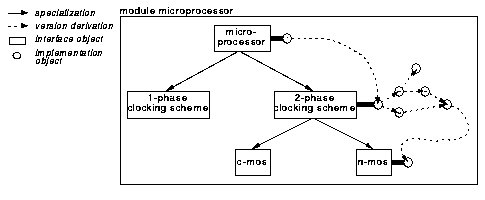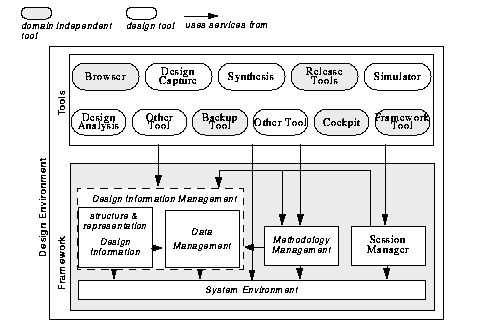[Table of Contents] |
[Stellingen, english version] |
[2. Integration] |
[Table of Contents] |
[Stellingen, english version] |
[2. Integration] |
Innovative electronic design requires close cooperation between system engineers, system architects and IC designers. Design environments with powerful facilities for design information management and browsing are needed to close the communication gap between these people [DeMan 92]. In this thesis we describe how to build an integrated environment for automated electronic design, based on the following observations:
While everybody does it, file-based encapsulation is generally considered to be a bad thing for the following reasons:
We do not attempt to overcome the overhead of design file parsing. Design units are still transported to and from design tools using files as carriers. However, the designer has finer and more flexible control over the selection of design units to be fed to a design tool. Design files are dynamically created from a selected set of design units to be manipulated during a particular design tool run. Hence, the design files fed to a design tool need only contain the necessary design units and thus can be smaller.
We have chosen the following approach to design tool encapsulation:
The distinction between domains and levels of detail leads to the following
Synthesis steps transform design objects from a low level of detail in the behavioural domain to higher levels of detail in the structural or physical domains (Figure 1). Synthesis steps are one-to-many transformations, e.g. there are a number of possible sets of ALUs, MUXs, registers, etc. (structural domain) implementing a set of register transfers (behavioural domain). Exploring the design space means to construct a compound design object from any of a number of alternative sets of design objects from the behavioural, structural, or physical domains. This implies that although a design object is associated with a specific domain, it may itself be composed of design objects from different domains. Quite commonly, alternative decompositions of a design object are used for different domains and different levels of detail.
An electronic module realizes a specific electrical behaviour. This behaviour can only be controlled and observed through its interface. An interface has a number of interface elements which are used to interface the module with the outside world. The behaviour on a very low level of detail (i.e. on architectural level) is reflected in a core interface. The more refined the specification becomes on higher levels of detail, the more the data types for interface elements are refined [Wagner 91]. Table 1 gives some typical data types for interface elements on different levels of detail in the behavioural domain.
| Level of detail | Typical data types for interface elements |
|---|---|
| architecture | Ethernet, RS-232, SBus |
| algorithm | integer, float, array, record |
| functional block | bit, bus, bundle |
| logic | bit_7 |
| transistors | 0..3 Volt |
In addition to data type refinement, there may be completely new interface elements on higher levels of detail:
| Domain | Interface primitives |
|---|---|
| behavioural | variables |
| structural | signal ports |
| physical | geometries |
Moving to a different domain, however, will almost certainly change the interface, simply because the interface primitives are different (Table 2). Especially design objects in the physical domain have interfaces that are non-isomorphic with those in the behavioural and structural domains due to the radically different kind of information represented in this domain.
 |
Interfaces in one module are related to each other in an inheritance tree each node of which is a refinement of its parent (Figure 2). It may add or refine interface elements defined by its parent. Arranging interfaces in inheritance trees ensures that interfaces in a module are compatible to each other in the sense that refined interfaces can only add new interface elements or refine existing ones but can not introduce incompatible changes such as deleting interface elements or introducing incompatible type changes. An interface may be associated with a graph of implementations, each of which defines an exact realization of behaviour, structure, or geometry.
There are two important observations related to hierarchical composition:
First, the interface of each functional block is defined and only then are the individual block implementations realized. The high-level behavioural design description is then stepwise transformed into a physical description on circuit level. A number of commercial and research synthesis tools exist to automatically perform these transformations on functional block level, logic and circuit levels [Walker 91]. Apart from synthesis tools, there are extraction and simulation tools that validate design results and allow to compare the behaviour of implementations in different domains and on different levels of detail (cf. for example [Greiner 93]).
While exploring design alternatives for a complex module, the selection of a specific implementation of a component needs to be flexible. On the other hand, once a module is released to a customer or other developers, its composition must be well-defined and fixed. We use configurations to provide this flexibility.
During early design stages, it is appropriate to always select a working implementation of a component by some default selection rule. Depending on the design task, however, the explicit selection of implementations from different levels of detail and from different domains may be more appropriate. Or, the designer of a module used as component in other modules may designate a selected implementation as the default, leaving it up to the designers of compound modules to select other implementations for special purposes. During simulation, for example, only questionable components need to be simulated to full detail. Other components may just be simulated behaviourally at a low level of detail. Designers will want to build a specific configuration of a design object for different design tasks and store them in the framework database alongside the actual design objects.
On the other hand, after five years in existence, the Design Representation Programming Interface [CFI-DRPI 93] defined by the CAD Framework Initiative (CFI), the dominant standardization body in the field, is still restricted to representing electrical connectivity data. Electrical connectivity deals with structural aspects of a design on functional block, logic, and circuit levels. As can be seen in the Y-Chart (Figure 1 on page 8), it does not cover all aspects necessary to describe a complete electronic design. To conclude, it is to be expected that language-based design tool interoperability will be common-place for some more years.
This definition is in line with the terms "representational details" and "structural details" as used by Katz et. al. in [Katz 86]. Structural information sometimes is called "meta-data", representation information is referred to as "raw design data" [vanderWolf 90]. Structural information is accessed by designers in an ad-hoc, query-by-value manner to understand the disposition and history of their design. It is mostly independent of domain and level of detail. Representational information, on the other hand, is accessed by designers and design tools in a navigational manner to get detailed knowledge about the behaviour, structure, and physical properties of a design.
A design environment should serve as an electronic note book to the design team, forming the information basis for more formal forms of project documentation like project binders and manuals. It maintains design information in a component dedicated to the management of design information. The task of this component is to keep structural information accessible, up-to-date and consistent with regard to representation information. Both parts of design information have to be managed in a protected environment to assure that it correctly reflects the state of the design, even in a multi-user environment. A framework component for data management provides basic services like locking, concurrent access, transactions, and object versioning.
The CAD Framework Initiative suggests the architecture shown in Figure 3 as the reference architecture for a design environment [CFI-FAR 93]. According to this architecture, a design environment consists of a framework, domain independent tools and design tools. To build an environment complying with this structure, design tools have to be integrated with the framework components.
 |
To summarize, in the area of electronic design we have to meet the following requirements on the management of design information, on design methodologies, and on design environments:
A design project could adhere to the policy that design files describe only single design objects. This way, design files could serve as representatives for design objects and can be used as end-points of relationships and holder of attributes. Whereas input files can be purposefully arranged by a designer to describe only single design objects, the contents of result files are under the control of design tools and beyond the control of the designer. If there is no support from the framework, the designer has to manually analyse the contents of result files, split them at design unit borders and insert them as single files into the data management component. In addition, relationships among result design objects and between derived design objects and the originals already in the database have to be established manually. This is the necessary mode of operation in the JESSI Common Framework [JCF 94a].
In this thesis, we will describe a new framework service that helps to encapsulate design tools to avoid this tedious and error-prone manual processing. Its design is based on the three principles we will develop in Chapter 2. Following these principles, design tools are encapsulated into the framework. No access to tool source code is required. With the assumption that commercial design tools interface to design descriptions by means of file input and output, we need to extract structural information and representational information from design files on import into the design information management system and to reconstruct valid design files on export from this system. Using this approach, it is possible to use the browsing and querying facilities of existing framework tools, regardless of whether design objects have been created by tightly integrated tools or by encapsulated, file-based tools. In Chapter 7 we discuss a prototype design environment based on the new integration service that supports the VHDL language. The prototype has been implemented both on the Nelsis CAD Framework and on the object-oriented database management system ObjectStore and encapsulates some design tools from the Synopsys suite of synthesis tools [Schettler 94a].
[Table of Contents] |
[Stellingen, english version] |
[Top of Chapter] | [2. Integration] |